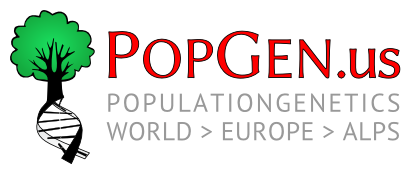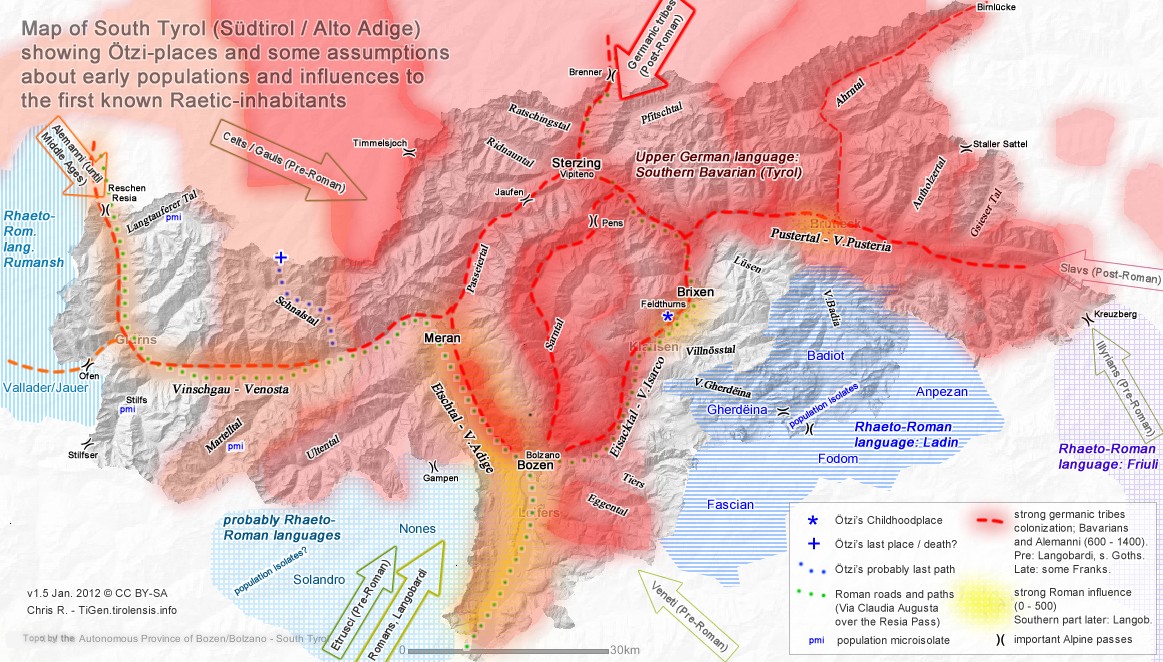This page tries to show some of the most interesting background of this subdivision of the historical Tyrol by the view of a genetic genealogist with interest in population genetics. Nowadays melting pot seems to have developed in some waves: beginning with Ötzi the Iceman‘s time there where many changes. The main migrations seems to have happened in the Iron Age, under Roman power, in the Migration Period and in the 20th century.
Inhaltsverzeichnis
History overview
South Tyrol oldest ethnic group are the Ladins. They speak a Rhaeto-Romance language developed from the local Raeti after the Romanization. The Raeti are a mysterious alpine people, with a own language (Raetic language) which had a strong influence (or descending) from Etrusci (Raetic alphabets), Noricans, other Italic peoples and maybe Illyrians (some wine terms still exist today) and also Celts/Gauls.
Sources tell of the first contact of Romans to Noricum in the Apenninon (Alps) 170 BC. From then to the Roman conquest of Tyrolean places in 15 BC to later a bunch of local tribes where named by sources: Tridentini in the Atesis valley (arround Trento), Anauni (Non Valley), Isarci (in the Etsch valley arround Bozen), Venostes in the Isara valley (Vinschgau), Atacini in the Atax valley (Eisack/Isarco), Scaredrani (in the Eggen valley?), Saevates in the Byrrus valley (Puster valley), Laianoi in the young Dravus valley (East Tyrol), Focunates in the young Aenus valley and on the Likas river (arround Landeck) and Breuni in the Aenus valley (arround Innsbruck). The Roman era left deep impressions on culture and language, similar to other European civilizations. Not much information is available how many people immigrated under Roman influence (until 500 AD).
Beginning with the Ostrogoths (Theodoric the Great 493 AD) the Germanic tribes take over Tyrol lands. First the nobles and warriors broke resistance and took land and then settlers followed. In the Southern part the Langobards where rulers (569 – 788). In the northern part the Bavarians took over the power and many settlers followed. From the east some Southern Slavs tried to enter and had influence. In the northwest the Alamanni had influence. After 788 the Bavarians ruled most parts of Tyrol and their German dialect is still today the dominating language. Settling activity probably was common until the 15th Century. Probably Hungarians/Magyars in the 10th century had a short influence.
In the upper Vinschgau/Venosta valley until some centuries ago the Romansh language was common. The time of Andreas Hofer (until 1809) was crucial for Tirolean patriots. Especially after the middle of the 19th century a food and work crisis, pushed many Tiroleans to leave (some also for colonisation lands like in America). Before non-catholic-religion was the major reason for emigration.
The next big change was after 1918. Italy had received the southern part of Tyrol from Austria (South Tyrol and Trentino). The fascist rulers from 1923 to 1943 tried to totally Italianize South Tyrol and many Italians where settled in the main towns. At the same time Indigenous people was leaving mainly to northern german speaking lands. After 1945 the german/tyrolese speaking people fight for rights and 1972 the autonomous province of South Tyrol was reality. The spoken Languages have changed a lot: 1910 89 % German, 4 % Ladin and 3 % Italian; 2001 64 % German, 4 % Ladin and 25 % Italian. But in the countryside still today Tyrolese and Ladin culture is dominating.
The Admixture between the ethnic groups in the last decades has increased, but is still primarily limited to the towns, so that many have ancestors mainly from one group. For scholars population (micro) isolates in the Ladin Valleys and upper Vinschgau/Venosta are interesting.
Map South Tyrol with historical migrations
Possible crucial events for migration Tyrol, Central Europe, Europe
This list is in construction and not finished
- 1347 arrival of the Black Death in Europe, century-long European demographic decline.
- 1258 Volcan Eruption: by ice findings the biggest in the last 10000 years, responsible for climate change. Little Ice Age. [1]
- 535-36 volcanic event: depressed the temperature of the earth for years. [2]
- 6000 – 2500 BC: Holocene Climate Optimum. Sea level higher than today. warmest period of the past 10000 years with temperatures about 2 degrees celsius higher than today.
- 7500 BC: melting of the ice sheets, flooding of many basins and disappearance of connecting land bridges
Greater migrations and history of bordering regions
- Germanic peoples ethno-linguistic group also called Teutonic or Gothic
- Early Slavs tribal societies in Migration period and early medieval Europe (ca. 5th to 10th centuries)
See also
Tyrolean DNA admixture and genetic structure
References
- ↑ http://www.nature.com/ngeo/journal/v5/n3/full/ngeo1394.html http://www.agu.org/pubs/crossref/pip/2011GL050168.shtml http://www.earth-syst-sci-data-discuss.net/5/1/2012/essdd-5-1-2012-print.pdf http://www.spiegel.de/wissenschaft/natur/0,1518,821162,00.html
- ↑ http://www.eh-resources.org/timeline/timeline_me.html


